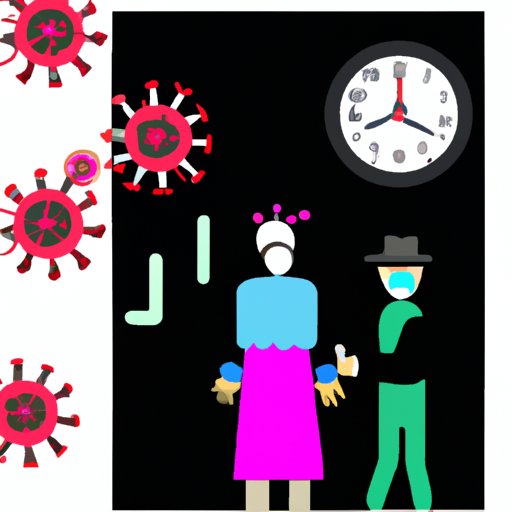Introduction
Influenza, commonly known as the flu, is a contagious respiratory illness caused by various influenza viruses. The flu can cause mild to severe symptoms and can even lead to hospitalization or death in some cases. It is important to understand when you are no longer contagious with the flu so that you can properly protect yourself and others from getting sick.
In this article, we will explore the duration of flu contagiousness and examine the science behind it. We will also look at what measures should be taken to reduce the risk of spreading the flu and when you can stop worrying about spreading it.
Exploring the Duration of Flu Contagiousness
How long does the flu remain contagious? This is an important question to consider when trying to protect yourself and others from getting sick. The answer depends on several factors, including the type of flu virus, the severity of symptoms, and the overall health of the infected person.
What Factors Affect the Length of Time a Person Is Contagious?
The type of flu virus is an important factor in determining how long someone is contagious. Some strains of the flu are more contagious than others and may last longer in the body. Additionally, the severity of symptoms can also play a role in how long a person is contagious. People who have more severe symptoms may be contagious for a longer period of time than those with milder symptoms.
The overall health of the infected person is also important. People who have weakened immune systems may be more likely to spread the virus for a longer period of time, while people with stronger immune systems may be less likely to spread it.
How Long Can an Infected Person Spread the Flu?
Typically, an infected person can spread the flu for up to five days after symptoms appear. However, this can vary depending on the factors mentioned above. For example, if the person has severe symptoms or a weakened immune system, they may be contagious for longer than five days. It is important to note that people can also spread the virus before symptoms even appear, which is why it is important to take precautions even if you are feeling well.

Understanding When You Can Stop Worrying About Spreading the Flu
Now that we have a better understanding of how long someone is contagious with the flu, let’s examine the science behind it. This will help us determine when we can stop worrying about spreading the virus.
What Role Do Viral Loads Play in Flu Contagion?
Viral loads refer to the amount of virus present in an infected person’s body. The higher the viral load, the more contagious the person is. As the virus replicates in the body, the viral load increases, making the person more likely to spread the virus to others. Once the viral load decreases, the person is less likely to spread the virus.
How Does Humidity Affect the Spread of the Flu?
Humidity can also play a role in the spread of the flu. In general, the higher the humidity, the more likely the virus is to survive and spread from person to person. Low humidity can inhibit the virus’ ability to survive and spread, making it less likely for the virus to infect others.

Unveiling the Length of Time an Infected Person Can Spread the Flu
Now that we have explored the role of viral loads and humidity in the spread of the flu, let’s take a closer look at how long an infected person can spread the virus.
How Long After Symptoms Appear Is an Infected Person Still Contagious?
An infected person can typically spread the virus for up to five days after symptoms appear. It is important to note that people can also spread the virus before symptoms even appear, so it is important to take precautions even if you are feeling well.
Does Taking Antiviral Medication Shorten the Duration of Contagiousness?
Taking antiviral medication can shorten the duration of contagiousness. These medications can help reduce the amount of virus present in the body, which can help reduce the risk of spreading the virus to others.
What Are the Different Stages of Flu Contagiousness?
There are three stages of flu contagiousness: pre-symptomatic, symptomatic, and post-symptomatic. During the pre-symptomatic stage, the infected person is contagious but does not yet show any symptoms. During the symptomatic stage, the person shows symptoms and is most contagious. During the post-symptomatic stage, the person is still contagious but the risk of spreading the virus is lower than during the symptomatic stage.

Knowing When You No Longer Need to Isolate Yourself From Others During Flu Season
Now that we have a better understanding of how long someone is contagious with the flu, let’s look at what measures should be taken to reduce the risk of spreading the virus and when you can stop worrying about spreading it.
What Measures Should You Take to Reduce the Risk of Spreading the Flu?
It is important to take steps to reduce the risk of spreading the flu. This includes washing your hands often, avoiding close contact with people who are sick, and staying home if you are feeling ill. Additionally, it is important to get a flu shot each year to help protect yourself and others from the virus.
What Precautions Should You Take If You Have Been Exposed to the Flu?
If you have been exposed to the flu, it is important to take extra precautions to prevent the spread of the virus. This includes washing your hands often, avoiding close contact with people who are sick, and staying home if you are feeling ill. Additionally, it is important to seek medical attention if you begin to experience symptoms of the flu.
How Can You Protect Yourself and Others From the Flu?
The best way to protect yourself and others from the flu is to get a flu shot each year and practice good hygiene habits. It is also important to avoid close contact with people who are sick and stay home if you are feeling ill. By following these simple steps, you can help reduce the risk of spreading the virus.
Conclusion
In conclusion, understanding when you are no longer contagious with the flu is an important part of protecting yourself and others from getting sick. The duration of contagiousness varies depending on the type of virus, the severity of symptoms, and the overall health of the infected person. Generally, an infected person is contagious for up to five days after symptoms appear. It is important to take precautions to reduce the risk of spreading the virus, such as washing your hands often and avoiding close contact with people who are sick. By following these simple steps, you can help protect yourself and others from the flu this season.
(Note: Is this article not meeting your expectations? Do you have knowledge or insights to share? Unlock new opportunities and expand your reach by joining our authors team. Click Registration to join us and share your expertise with our readers.)
